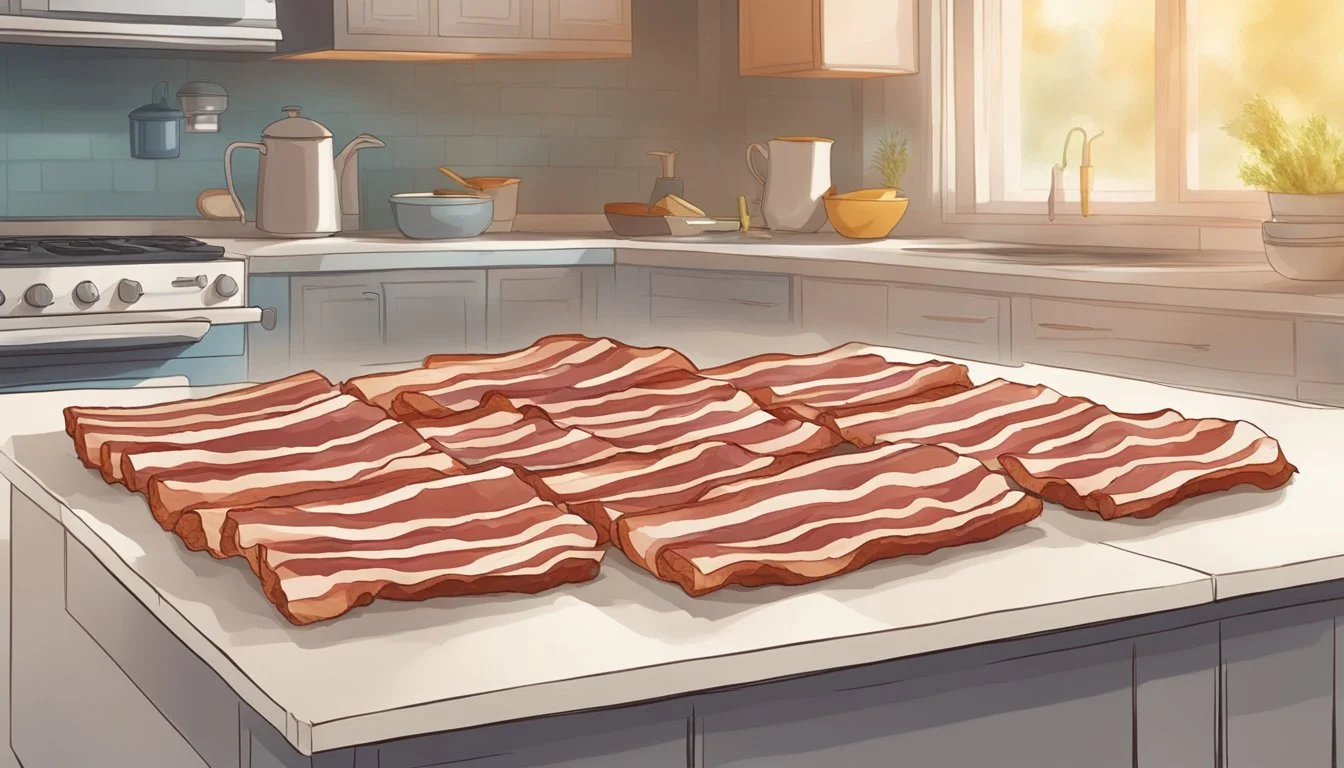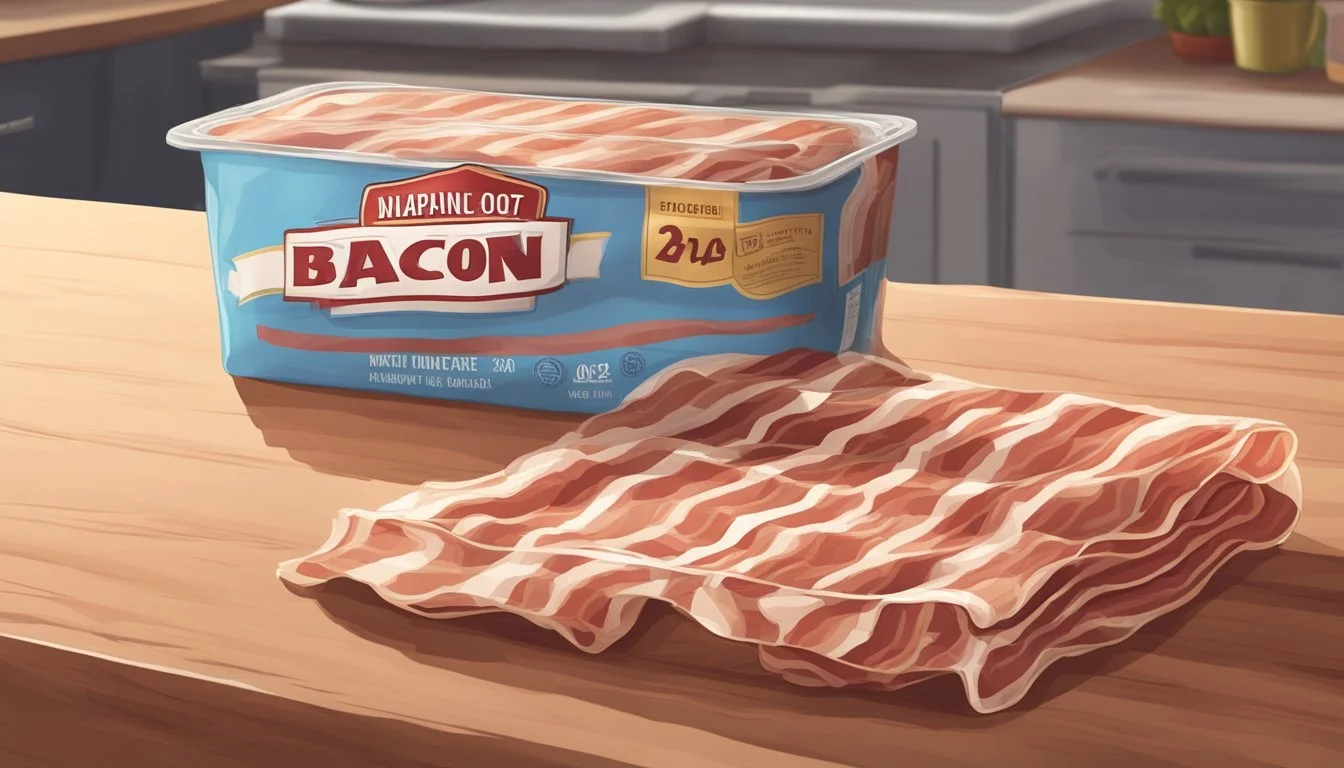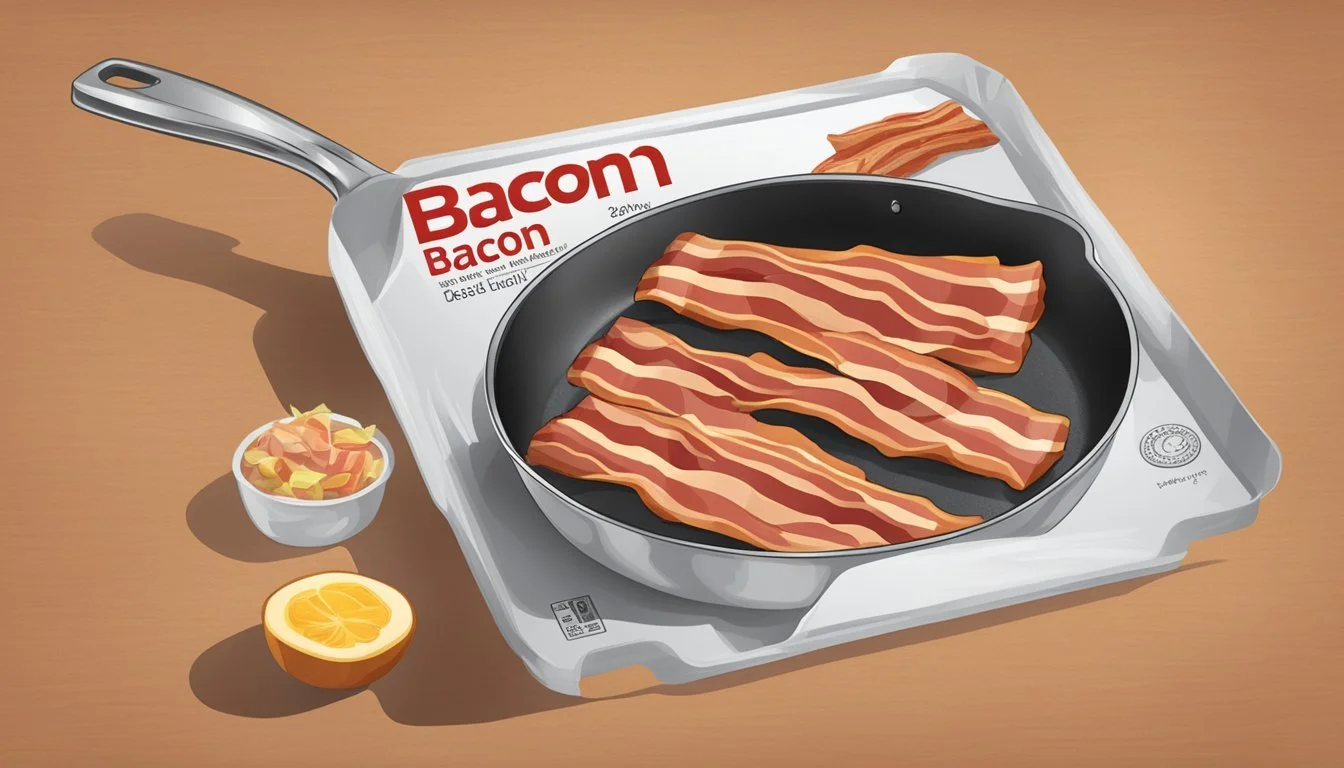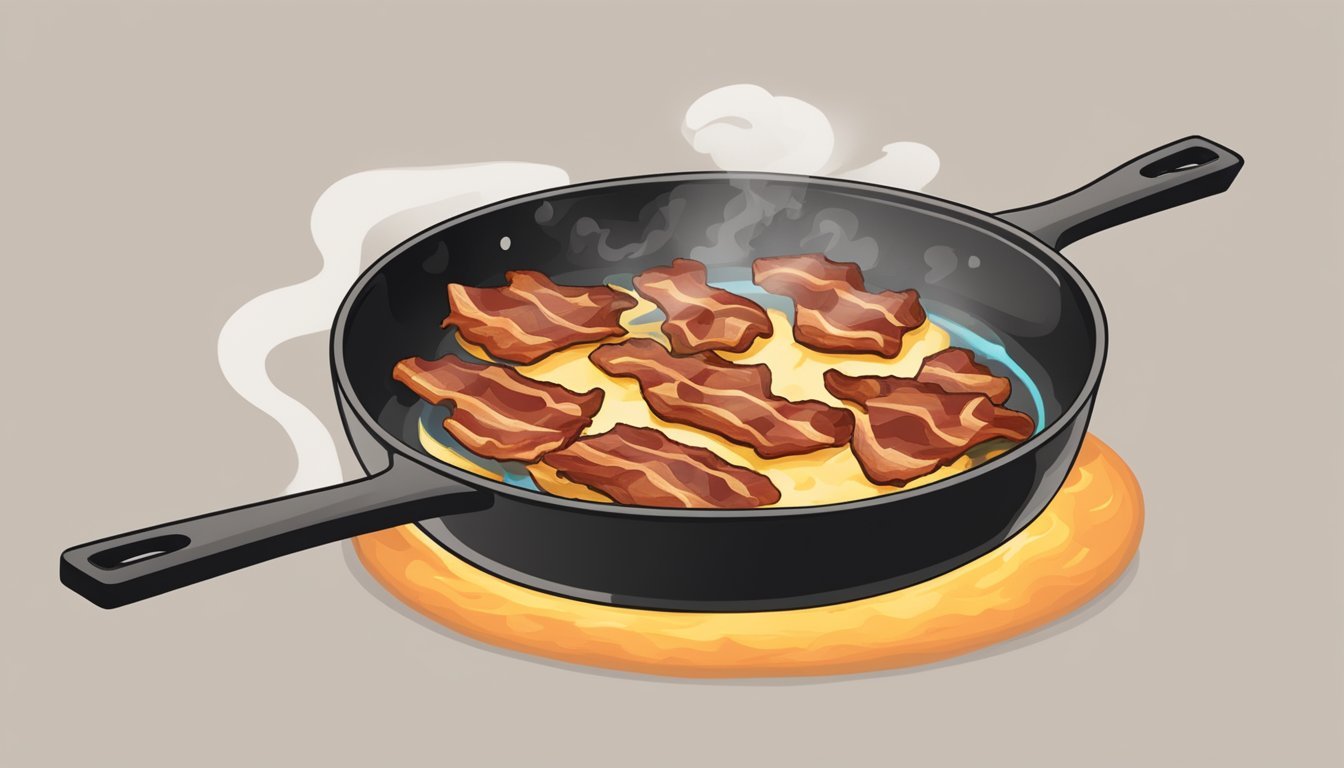Does Bacon Go Bad?
Understanding Shelf Life and Storage Tips
Bacon is a popular and versatile food enjoyed by many for its rich smoky flavor. It comes both in fresh and cured forms, and like all perishable foods, it is subject to spoilage if not stored and handled correctly. Recognizing when bacon has gone bad is key to ensuring food safety and avoiding consumption that could lead to foodborne illness.
Shelf life varies for different types of bacon, and several factors influence its longevity, including the way it's processed, how it's stored, and whether it has been opened. Refrigerated bacon typically has a sell-by date, and once opened, it's best consumed within a week to ensure freshness. It's important for consumers to understand the signs of spoilage to prevent the risks associated with eating spoiled bacon.
Spoilage is detectable through changes in the bacon's appearance, smell, and texture. Fresh bacon should have a natural meaty smell, a moist touch, and a bright pink color with white or yellowish fat. If any of these characteristics begin to deviate, such as the presence of a sour or rancid smell, a slimy texture, or a dull, greyed color, this indicates that the bacon may no longer be safe to eat.
Bacon Basics
Within this section, we explore the essence of bacon, from its definition to the various types available on the market, ensuring a comprehensive understanding of this popular meat product.
Defining Bacon
Bacon is a type of salt-cured meat, predominantly made from pork. It usually comes from the belly or back cuts of a pig and is known for its rich, smoky flavor. After curing, bacon can be either smoked or left unsmoked, a process that further intensifies its distinct taste.
Types of Bacon
The market offers several types of bacon, each varying in flavor, texture, and preparation method.
Pork Bacon: The traditional variety, typically cured and smoked to bring out its characteristic flavor.
Pancetta: An Italian bacon made of pork belly meat that is salt cured and spiced with black pepper and, sometimes, other spices.
Canadian Bacon: Made from the pork loin, this bacon is leaner and is more similar to ham in taste and texture.
Turkey Bacon: A low-fat alternative to regular bacon, made from processed turkey and often flavored to resemble the taste of pork bacon.
All-Natural Bacon: This refers to bacon with no artificial ingredients or preservatives, such as Coleman Natural Hickory Smoked Uncured Bacon, and may be minimally processed.
Identifying Spoiled Bacon
When checking for spoiled bacon, it's crucial to observe the appearance, smell, and texture of the meat, as changes in these areas typically indicate spoilage.
Signs of Spoilage
There are four main signs that bacon has gone bad which are important to recognize:
Smell: Spoiled bacon will often have a sour or rancid odor.
Texture: Fresh bacon should be moist and tender, not slimy or sticky.
Color: Look for a natural pink color with white or yellowish fat. Discoloration is a warning sign.
Mold: Visible mold growth, which could appear as green or white fuzz, is a clear indication the bacon is spoiled.
Smell Test
One of the quickest ways to detect spoilage is by smelling the bacon. Fresh bacon typically has a mild, smoky scent. If the bacon emits a sour or sulfuric odor, it may have gone bad due to bacterial growth.
Texture and Color
Bacon should feel firm to the touch, not slimy or sticky. When bacon starts to spoil, its texture changes due to bacterial activity. The color should be consistent; discolored spots, especially greenish-grey or brown, indicate spoilage.
Mold and Bacteria Growth
Inspect bacon carefully for signs of mold or bacteria growth. Mold may appear as green or white patches. Any moldy or funky growths are a sign that the bacon is no longer safe for consumption.
Health Concerns
When consuming bacon, it's crucial to consider potential health risks such as foodborne illnesses and the presence of viruses and parasites. Appropriate handling and cooking can mitigate these risks.
Foodborne Illnesses
Bacteria Growth: Bacon can harbor bacteria like E. coli and Salmonella, which proliferate when the meat is not properly stored or cooked. Symptoms of food poisoning can include nausea, vomiting, and diarrhea. Ensuring bacon is stored below 40°F and cooked to an internal temperature of 145°F can prevent bacteria growth.
Symptoms of Foodborne Illness: Exposure to harmful bacteria in bacon can result in:
Abdominal cramps
Fever
Headache
Prompt medical attention is advised when symptoms persist or worsen.
Viruses and Parasites
Viruses: While less common, viruses can contaminate bacon. Norovirus can be transmitted through bacon if it comes into contact with infected food handlers.
Parasites: Consuming undercooked bacon can lead to parasitic infections such as:
Toxoplasmosis: Caused by Toxoplasma gondii, typically affects individuals with weakened immune systems.
Trichinosis: Resulting from Trichinella species, this parasite is eliminated when bacon is cooked to safe temperatures.
Avoiding undercooked meats and practicing sanitation when handling bacon can help prevent these illnesses.
Storing Bacon
Proper storage is essential to maintain the freshness and quality of bacon. This section will guide you on how to store uncooked and cooked bacon to extend shelf life and prevent spoilage.
Uncooked Bacon Storage
Uncooked bacon should be stored in the refrigerator or freezer immediately after purchase. In the refrigerator, one should place the bacon in its original packaging if unopened, or a sealed container or plastic bag if opened, to protect it from contaminants and moisture.
Refrigerator: Up to two weeks for unopened packages; one week for opened.
Freezer: Up to one month to maintain optimal quality, avoiding freezer burn; however, it may remain safe beyond this period.
Cooked Bacon Storage
Once bacon is cooked, it should be stored in the refrigerator within two hours of cooking. The bacon should be placed in an airtight container or wrapped tightly in aluminum foil or a plastic bag to ensure it remains food safe.
Refrigerator: Lasts four to five days.
Freezer: Properly stored cooked bacon can last up to one month to maximize taste and quality, though it remains safe to eat beyond that if properly frozen.
To maintain safety and taste, one must handle bacon with clean hands and use clean utensils when transferring bacon to storage containers.
Preservation Techniques
Proper preservation techniques are essential to prevent bacon from going bad. These methods focus on controlling temperature and reducing exposure to air, which can encourage bacterial growth and spoilage.
Freezing Methods
When one aims to preserve bacon for extended periods, freezing is an effective method. It is recommended to wrap the bacon tightly in aluminum foil or plastic wrap to minimize air exposure. For additional protection, placing the wrapped bacon in a zip-top bag or airtight container can help prevent freezer burn and maintain quality.
Individual Quick Freezing: To freeze bacon slices individually, lay them flat on a baking sheet lined with wax paper and place in the freezer. Once frozen, transfer them to an airtight container or zip-top bag.
Bulk Freezing: For larger quantities, one can freeze the entire package of bacon as is but should consider double-wrapping with aluminum foil for added protection.
Refrigeration Tips
Refrigeration is key for short-term bacon storage. Bacon should be kept in its original packaging until it needs to be used. Once opened, it's crucial to rewrap any unused bacon in plastic wrap or place it in an airtight container and refrigerate promptly.
Temperature Consistency: Maintain refrigerator temperature at a consistent 40°F (4°C) to ensure optimal preservation.
Separate from Other Foods: To prevent cross-contamination, store bacon away from other foods, ideally in a dedicated compartment or on the lower shelf.
Using these storage methods systematically can effectively thwart the spoilage of bacon, keeping it safe and delicious for future use.
Usage and Consumption
When it comes to bacon, understanding proper usage and consumption ensures both safety and enjoyment. The reader should be aware of when to eat bacon based on dates, the best methods to cook bacon to achieve desired crispiness, and creative recipes to make the most out of every package.
When to Eat Bacon
Individuals should consume bacon before the "use by" date indicated on the package. Unopened bacon typically lasts up to 2 weeks in the refrigerator and up to 8 months in the freezer. Once opened, bacon should be eaten within a week, though proper storage can slightly extend this timeframe.
Sell by date: Safe to eat up to 7 days after this date if stored correctly.
Use by date: Do not consume past this date to avoid potential foodborne illness.
Interpreting packaging dates is crucial, where the Julian date code may also be referenced, reflecting the packing date.
Cooking Methods
There are multiple methods to cook bacon, and each can impact flavor and texture:
Pan Frying: The traditional method for achieving crisp bacon. It should be done over medium heat, turning occasionally.
Oven Baking: Laying bacon on a sheet in a preheated oven at 400°F (200°C) typically for 15-20 minutes results in evenly cooked and less greasy bacon.
Microwaving: Quick and effective for a small batch, usually involving layering bacon between paper towels and cooking for about 1 minute per slice.
Air Frying: A modern approach like making air fryer bacon-wrapped sweet potatoes, offering a crispy result with the added benefit of less grease.
Always discard bacon grease properly, rather than pouring it down the drain, to avoid plumbing issues.
Recipe Ideas
Diverse bacon recipes cater to all meals, from breakfast to dinner:
Breakfast: Classic cooked bacon served alongside eggs, or chopped into bacon bits for an omelet.
Lunch: An herb pork cubano sandwich offers a zesty twist to the midday meal.
Dinner: Corn and bacon chowder is a hearty option that infuses the smoky flavor of bacon into every spoonful.
When creating meals, always consider the type of bacon being used, as different cuts and flavors can alter the final dish.
Buying Guidelines
When purchasing bacon, consumers should pay attention to packaging labels, which provide essential information about the freshness and expected shelf life of the product, and the visual cues of the bacon's quality, ensuring they select the freshest and safest bacon available.
Understanding Packaging Labels
Sell-By Date: This label indicates the last date the store should display the product for sale. For unopened bacon, one can safely use it within approximately one week after the sell-by date if it has been stored properly.
Use By Date: Unlike the sell-by date, the use by date is closer to an expiration date. It suggests when the bacon may start to decrease in quality. Bacon, both opened and unopened, should be consumed by this date. If the package is opened, the bacon should be used within seven days for optimal freshness.
It is important to store bacon in the refrigerator at 40°F (4.4°C) or below, immediately after purchase. For long-term storage, uncooked bacon can be frozen for up to two months.
Selecting Quality Bacon
When choosing high-quality bacon, look for cuts that exhibit long streaks of pink meat with a moderate amount of fat. A balance between meat and fat contributes to flavor and texture; excessively fatty or very lean cuts may not provide the desired culinary results. An unopened package of bacon should be firm to the touch and free from any discoloration, off-odors, or slimy residue. High-quality bacon, when chosen carefully and stored properly, can be a delicious addition to many meals.
Safety Tips
When handling bacon, adhering to safety protocols is essential to prevent foodborne illness. Maintaining food safety involves avoiding cross-contamination and following proper thawing procedures.
Avoiding Cross-Contamination
One should always use separate cutting boards and utensils for raw bacon and other ingredients. Bacon grease, a by-product of cooking bacon, should be handled with care and never poured down the drain as it can solidify and cause blockages. Instead, it's advisable to dispose of it in a sealed container. Refrigerating bacon at a temperature below 40°F (4°C) can help prevent the growth of harmful bacteria.
Do: Use separate utensils and surfaces.
Don't: Allow bacon or its grease to come into contact with other foods that won’t be cooked.
Proper Thawing Procedures
Bacon should never be thawed at room temperature. To maintain food safety standards, it is recommended to thaw bacon in the refrigerator, in cold water, or in the microwave. Refrigerator thawing is the safest method, although it takes several hours. Cold water thawing is faster but requires the bacon to be in a leak-proof package submerged in cold water, with the water changed every 30 minutes. Microwave thawing is the quickest method, but the bacon must be cooked immediately after thawing to prevent bacterial growth.
Refrigerator Thawing: Safe but slow. Plan ahead.
Cold Water Thawing: Faster. Requires water changes.
Microwave Thawing: Quickest. Cook bacon immediately after.
Myths and Facts
When it comes to determining the shelf life of bacon, it's essential to differentiate between myths and verifiable facts. Misinformation can lead to improper food handling, while understanding the realities ensures safe consumption.
Common Misconceptions
Myth 1: Bacon, once cooked, cannot go bad. Contrary to this belief, cooked bacon can spoil and should be handled carefully to avoid foodborne illness.
Myth 2: All bacon appears visibly slimy or grey when bad. In fact, bacon may exhibit subtle changes not easily noticed by the eye.
Bacon Realities
Fact 1: Bacteria on bacon can manifest as a slimy texture or as a thick, sticky residue.
Fact 2: Mold on bacon usually appears as grey spots. These spots can harbor harmful bacteria.
Storing Cooked Bacon: Storage should be in an airtight container in the refrigerator to prolong its freshness.
Bacon Type Proper Storage Potential Issue Hickory Smoked Airtight container; refrigerated Hickory flavor can mask spoilage odors at early stages Regular Uncured Airtight container; refrigerated More prone to bacteria growth if not cured
Remember, bacon's scent should be smoky, not sour or foul. If it smells off, it should be discarded to prevent foodborne illness. Thinly sliced bacon tends to spoil faster than thick-cut variations due to a larger surface area exposed to bacteria.
Conclusion
Like all perishable foods, bacon is prone to spoilage. Proper storage is crucial to extending its shelf life. Uncooked bacon should be refrigerated at all times and ideally consumed within 10 days of purchase. If a longer shelf life is necessary, freezing is an effective option, potentially preserving the bacon for six to eight months.
When assessing bacon's freshness, one should look for key indicators such as:
Smell: Fresh bacon will have a slight smoky aroma. Any sour or rancid scent indicates spoilage.
Color: The color should be a rosy pink. A dull or gray hue suggests it's past its prime.
Texture: It should feel soft yet firm to the touch. A slimy or sticky texture is a clear sign of decay.
Bacon that's been cooked also needs careful storage, tightly sealed in the refrigerator, where it can last for about five to seven days. In both raw and cooked forms, bacon must never be left at room temperature for more than two hours to prevent the growth of harmful bacteria.
Consumers should always exercise caution if there are any doubts about bacon's freshness. Discarding questionable bacon is far preferable to risking foodborne illness. By understanding and adhering to these guidelines, bacon can be safely enjoyed as part of one's diet.










